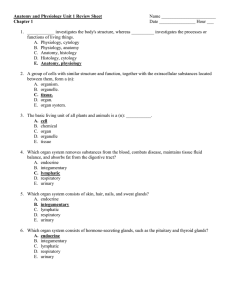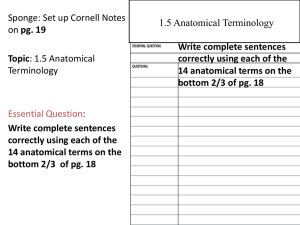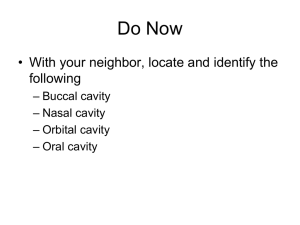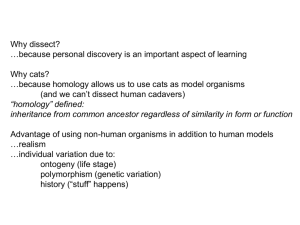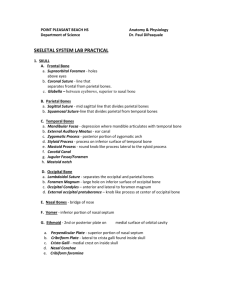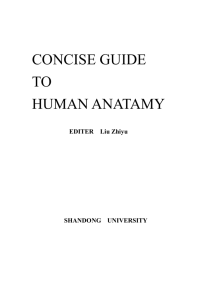Anatomy and Physiology Unit 1 Review Sheet Name Hour 1
advertisement
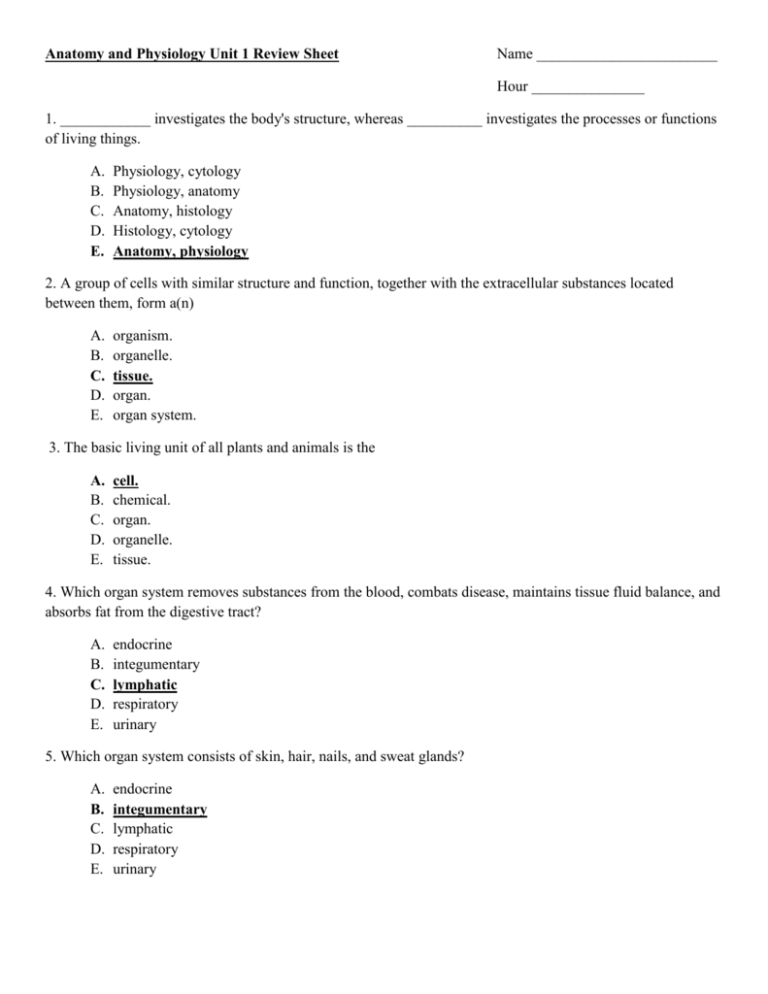
Anatomy and Physiology Unit 1 Review Sheet Name ________________________ Hour _______________ 1. ____________ investigates the body's structure, whereas __________ investigates the processes or functions of living things. A. B. C. D. E. Physiology, cytology Physiology, anatomy Anatomy, histology Histology, cytology Anatomy, physiology 2. A group of cells with similar structure and function, together with the extracellular substances located between them, form a(n) A. B. C. D. E. organism. organelle. tissue. organ. organ system. 3. The basic living unit of all plants and animals is the A. B. C. D. E. cell. chemical. organ. organelle. tissue. 4. Which organ system removes substances from the blood, combats disease, maintains tissue fluid balance, and absorbs fat from the digestive tract? A. B. C. D. E. endocrine integumentary lymphatic respiratory urinary 5. Which organ system consists of skin, hair, nails, and sweat glands? A. B. C. D. E. endocrine integumentary lymphatic respiratory urinary 6. Which organ system consists of hormone-secreting glands, such as the pituitary and thyroid glands? A. B. C. D. E. endocrine integumentary lymphatic respiratory urinary 7. Which of these characteristics of life helps maintain homeostasis when environmental conditions change? A. B. C. D. E. growth and development metabolism organization reproduction responsiveness 8. Development is a process that begins with fertilization and ends with A. B. C. D. E. birth. adolescence. adulthood. old age. death. 9. Given these terms related to negative-feedback: 1. control center 2. effector 3. receptor 4. response 5. Stimulus. Arrange them in the correct order as they operate to maintain homeostasis. A. B. C. D. E. 1,2,3,4,5 2,3,5,1,4 3,2,1,5,4 4,5,3,2,1 5,3,1,2,4 10. A body temperature of 98.6 degrees F (37 degrees C) is the __________ for body temperature. A. B. C. D. E. constant lower limit normal range set point upper limit 11. Which of these processes illustrates positive-feedback? A. B. C. D. E. increase in respiratory rate during exercise increase in heart rate when blood pressure decreases shivering when body temperature decreases increase in uterine contractions when uterine stretching increases during childbirth all of these 12. Failure of negative-feedback mechanisms to maintain homeostasis A. B. C. D. E. may produce disease. occurs when blood pressure increases during exercise. can be corrected by stimulating positive-feedback mechanisms. cannot be corrected by medical therapy. all of these 13. According to the concept of negative feedback, a slight increase in blood pressure causes a corresponding: A. increase in heart rate. B. decrease in heart rate. C. no change in heart rate. 14. To maintain homeostasis, the normal range of values for a variable A. B. C. D. is always below the set point. may change in different situations. may not deviate from the set point. occurs because of positive-feedback. 15. A term that means "away from the midline" is: A. B. C. D. E. distal lateral medial proximal superior 16. Which of these descriptions does NOT apply correctly to a person in the anatomic position? A. B. C. D. E. standing erect head facing forward feet facing forward arms hanging to the side palms facing toward the thighs 17. The scapula (shoulder blade) is __________ to the lung. A. B. C. D. dorsal posterior superficial all of these 18. The elbow is __________ to the wrist. A. B. C. D. E. distal inferior lateral medial proximal 19. The nose is __________ and __________ to the ears. A. B. C. D. E. anterior, proximal superior, lateral inferior, posterior anterior, medial superficial, medial 20. Which of the paired terms below are opposites? A. B. C. D. E. anterior and cephalic posterior and cephalic posterior and caudal superior and cephalic anterior and dorsal 21. Pancreatitis describes: A. B. C. D. E. inflammation of the pancreas. removal of the pancreas. cancer of the pancreas. secretions from the pancreas. death of the pancreas. 22. Given these directional terms: 1. caudal 2. cephalic 3. distal 4. inferior 5. proximal Which of these directional terms correctly describes the relationship of the ankle to the knee? A. B. C. D. E. 1,3 1,3,4 2,3,4 3,4 4,5 23. Which of these anatomical terms refers to the ankle? A. B. C. D. E. manus femoral carpal inguinal tarsal 24. Which of these anatomical terms refers to the shoulder? A. B. C. D. E. deltoid brachial cervical buccal digital 25. The only plane that can divide the body into equal halves is the A. B. C. D. E. frontal (coronal) plane. oblique plane. midsagittal plane. transverse plane. Serengeti plane. 26. A(n) __________ plane divides the body into superior and inferior portions. A. B. C. D. frontal (coronal) oblique sagittal transverse 27. What is another name for the frontal plane? ___Coronal________ 28. Which of these statements concerning body regions is correct? A. B. C. D. E. The pelvis is located between the thorax and abdomen. The leg extends from the knee to the ankle. The arm extends from the shoulder to the wrist. The trunk can be divided into the thoracic area and pelvis. The thorax is often subdivided superficially into four quadrants. 29. The cavity surrounded by the rib cage and bounded inferiorly by the diaphragm is the A. B. C. D. E. mediastinum. pericardial cavity. thoracic cavity abdomen. pelvic cavity. 30. Homeostatic imbalance has occurred when a A. B. C. D. E. person shivers as a result of being cold. person's heart rate increases as a result of exercise. person sweats as a result of being hot. person's breathing rate increases as a result of exercise. person becomes ill. 31. Select the option that shows increasing complexity levels. A. B. C. D. E. Organ system, organ, tissue, cellular Cellular, tissue, organ, organ system Organ, tissue, cellular, organ system Cellular, tissue, organ system, organ Tissue, organ, organ system, cellular 32. The opposite of superior is A. B. C. D. E. lateral. inferior. ventral. distal. superficial. 33. Which choice below is NOT one of the three components of homeostatic control systems? A. B. C. D. The control center The effector Stimulus (cause of the initial change) Receptor (senses the change) 34. The respiratory system contains the A. B. C. D. E. liver, small intestine, and colon. kidneys, ureters, and bladder. trachea, bronchi, and lungs. pituitary, pineal, and thyroid glands. uterus, vagina, and uterine tube. 35. The spleen is the largest organ in the A. B. C. D. E. nervous system. endocrine system respiratory system. lymphatic system. reproductive system. 36. Which of the following body systems acts as a fast-acting control system for the body? A. B. C. D. E. Reproductive Skeletal Respiratory Endocrine Nervous 37. Which of the following body systems functions to produce blood cells? A. B. C. D. E. Cardiovascular Reproductive Skeletal Respiratory Urinary 38. Which of the following is NOT a necessary human life function? A. B. C. D. E. Excretion Responsiveness Movement Intelligence Metabolism 39. Which one of the following is NOT a survival need? A. B. C. D. E. Pressure Food Water Transportation Oxygen 40. The simplest level of structural hierarchy is A. B. C. D. the organ level. the chemical level. the organismal level. the cellular level. 41. The ability to sense changes in the environment and respond to them is a physiological ability known as A. excretion. B. responsiveness. C. metabolism. 42. All of the following are correct positioning when placing the body in the anatomical position except A. B. C. D. the feet are slightly apart. the palms are facing forward. the body is "standing to attention". the thumbs are pointing medially. 43. Which of the following organs lies in the dorsal cavity? A. B. C. D. the lungs the kidney the spinal cord the stomach Give the “opposite” for each of the following directional terms. 44. caudal - cephalic 48. ventral - dorsal 45. lateral - medial 49. superficial - deep 46. distal - proximal 50. posterior – anterior 47. inferior- superior Circle the answer which will make the sentence correct. 51. The big toe is on the lateral/medial side of the foot? 52. The scapula is on the anterior/posterior side of the body? 53. The hand is distal/proximal to the elbow? 54. The hips are superior/inferior to the shoulders? 55. The shoulders are medial/lateral to the spine? 56. The knee is distal/proximal to the ankle? Complete using the terms superior and inferior. 57. The hands are _____Superior_____to the feet 58. The knees are _____Inferior____ to the waist. 59. The elbow is __Superior______ to the wrist. 60. The calf muscle is ___Superior__to the ankle. Complete using the terms anterior and posterior. 61. The heel is ____posterior____ to the toes. 62. The biceps are ___anterior_____ to the triceps. 63. The hamstring is ___posterior___to the quadriceps Complete using the terms lateral and medial. 64. The arms are ___lateral_____to the midline. 65. The neck is ____medial_____to the arms. 66. The shoulders are ___lateral___to the midline

